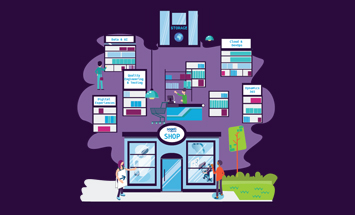How do we stay together while working apart?
In this blog post, Jonas Hultenius, Software Architecht at Sogeti and one of our global experts in SogetiLabs, writes about new strategies to keep teams connected and cohesive even when working remote. Feel free to reach out to Jonas if you would like to discuss the topic further.
The shift to remote work, accelerated by the global pandemic, has transformed the way we approach our professional lives. While the flexibility of remote work brings numerous benefits, it also presents challenges, chief among them being the need to foster a sense of togetherness among team members who are physically dispersed.
Now that remote work has become the norm, we need new strategies to keep teams connected and cohesive. We need change.
First of all, what is the best part of the office that we are lacking in our hybrid or remote setup today? The water cooler or, for us Swedes, the coffee machine.
In traditional office settings, casual conversations at the watercooler often fostered a sense of camaraderie. These micro meetings or brief interactions both brighten our days and let us connect in a more direct and less intimidating way that proper and planned actual meetings. We as social animals have a tendency to bounce ideas off each other and this interaction is in many ways key, not only to stay connected but also to drive ideas and the conversation forward.
The casual aspect lets anyone jump in and keeps the conversation open and non-secretive. Anyone can add to it and this fosters both a social and open environment but also a sense of belonging and being a part of something much bigger than oneself.
Translating this to the virtual realm, however, is no small feat and involves creating spaces for informal interactions. Virtual coffee breaks, dedicated chat channels for non-work conversations, and even online game sessions can serve as modern equivalents to the watercooler, providing opportunities for team members to connect on a personal level.
This is not an easy task and many company and manager have tried and failed over the last couple of years. It’s hard next to impossible to foster these types of interactions without making them feel forced or imposed upon you. It’s hard but not impossible. The best way, in my humble opinion, is to let these informal meeting places or digital watercoolers evolve organically. Given the opportunity and access to the right tools people will create these areas themselves and invite others and over time a community will have formed. We should facilitate these endeavors by not hindering them.
A central decreed stating that from now one we shall have informal meeting once a week at a given time will only have people running for the exits.
The next hurdle to overcome once we have created an environment where people want to connect and stay connected is the tools we use and how we use them. The toolset for our online interactions is lacking, to say the least, and is more or less the same as they were before the pandemic and even years and years before that. Not much has changed over the years and we tend to see things as a blur filter or background images as huge leaps forward. The fact remains, though, today’s online tools are just Skype 2.0 but with a new name and slab of paint added to it.
Communication lies at the heart of any successful team, and in a remote setting, it becomes even more crucial. So, we need something new that not only allows us to meet but helps us do exactly what the meeting is meant for in the first place, to communicate. Now, this is where we leave the classical setup and goes on a little adventure. I have over the last couple of weeks been conducting a number of tests with different groups of people to see what options there are and how we can use the tools that are available at our disposal. These are initial tests to find different possible solutions and further studies are needed to iron out all the kinks but all in all it has been an exciting couple of weeks.
First out we have the classical meetings that we are all used to by now in Skype, Teams and Zoom. The participants were asked a couple of questions before and after and the meetings were held with the camera mandatory on, off or optional. To no one’s surprise the meetings with cameras completely turned off yielded the worst results. The informal nature of these meeting, being a way to connect and socialize more than a meeting with an agenda, did not play well anonymity that one is given when the camera was off. Most people ended up being passive and just listening in to what was then more of a telephone call than a discussion or meeting of the minds.
With the camera on things didn’t fare much better. People were more present but not much more and when given the option to turn their cameras of most choose to do so, and do some actual work instead while just listening in. People also felt, when asked, that nothing was really gained so these meetings where just a slight waste of time.
Onward and upward, there must be a better way. Well, turns out there is: the Miro meeting.
Using the same setup, a meeting with the camera on in Microsoft Teams, but adding an open Miro board to the mix gave completely different results. When the subjects had a common space to occupy the same informal meeting from before lost something, the meeting part. People started to interact with the board and each other, the participants became more active both in the discussions (the actual talking) but also by sharing images and links.
The mood of these gatherings where also changed and became more casual and friendly, more social. There seems to be a direct connection between the visual element, to having something shared, to look at and talk about. Both for driving the discussions forward but also keeping the people doing the talking engaged.
Lastly, we have the gaming option. And this is something I will return to in a later blogpost once these tests have been completed and evaluated.
But initial testing has begun by letting a small group of test subjects, colleagues and friend, join a private server for a quick social gathering in the game Valheim. In Valheim you are a Viking, you can hunt and slay monsters, but also chop down trees, build houses and plant carrots. You can more or less do anything you want. In the first batch of tests I have joined a game with four other brave Viking warriors to just have a chat around the campfire, tend to the garden and just do some mindless (or actual mindful exploring) by boat. It turns out that while disconnecting from the real world and entering into this metaverse we actual got the watercooler or coffee machine effect going.
While doing these, often, mundane task we talked unhindered, about life, work and the world around us (both the real one and the digital Viking variant). And as an added benefit there was the unparalleled team-building effort of getting help from your friends after accidentally stealing a Trolls treasure and the shared rush of fleeing from the less than pleased victim.
There is definitely something to this that needs to be explored further!
So to round things off, we need to do something to break the circle of remote work and to rekindle the best things about the office but without having to return to it. Or at least return to it fulltime. The main hindrances we face today are the lackluster tools we have been given, or the way we use them. We are social animals and meetings are not meant to be social nor remote so as companies, organizations and private individuals settles in to the new normal we need to find new and better ways to keep together instead of drifting apart. It’s an investment in our collective future.
- Jonas HulteniusSoftware Architect & SogetiLabs Fellow, Sogeti Sweden
070-518 66 25
 Jonas HulteniusSoftware Architect & SogetiLabs Fellow, Sogeti Sweden
Jonas HulteniusSoftware Architect & SogetiLabs Fellow, Sogeti Sweden
070-518 66 25






